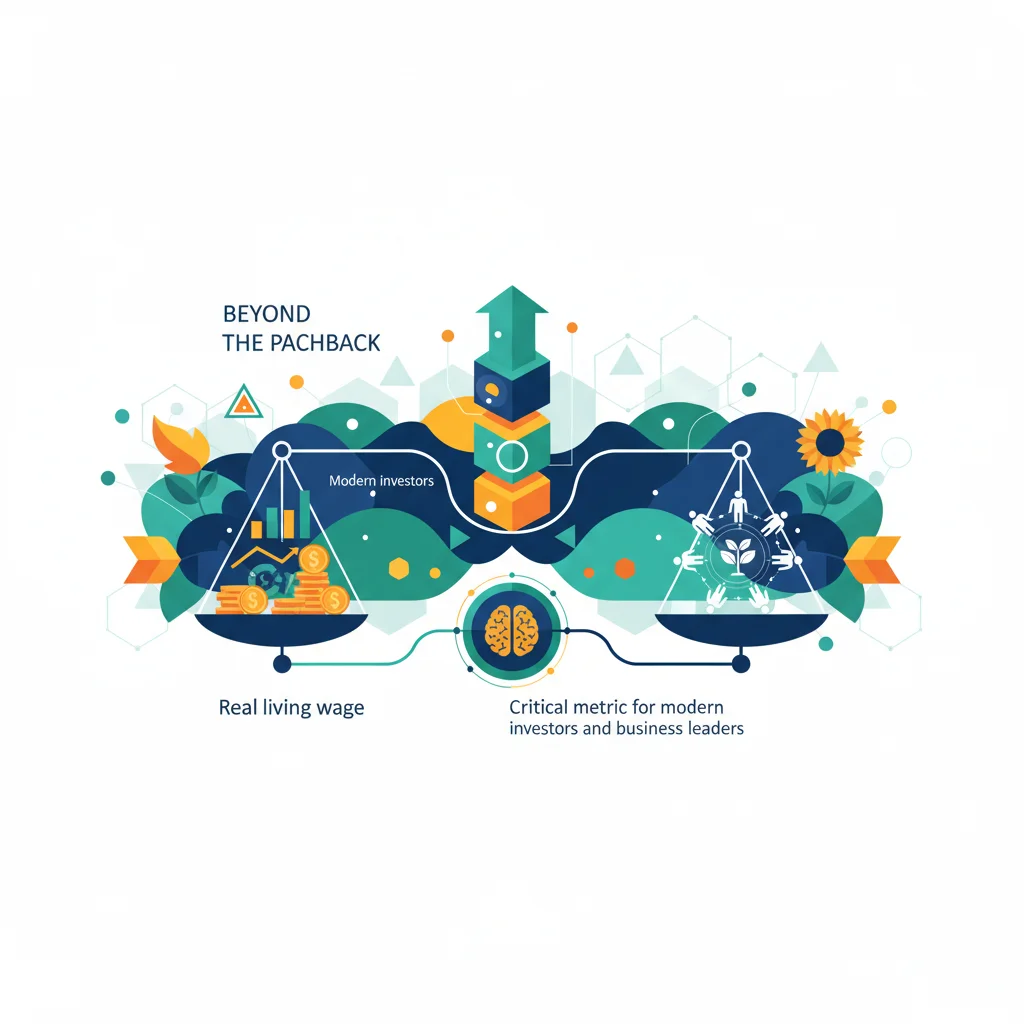
Beyond the Paycheck: Why the Real Living Wage is a Critical Metric for Modern Investors and Business Leaders
In the complex world of modern finance, a company’s value is no longer measured solely by its balance sheet. A new, more holistic view is emerging—one where corporate responsibility, employee well-being, and long-term sustainability are critical indicators of financial health. At the heart of this paradigm shift lies a simple yet powerful concept: the wage. Recently, campaigners have amplified their call for more businesses to adopt the ‘real living wage’, sparking a crucial conversation that extends far beyond ethics and into the core of business strategy, economic stability, and intelligent investing.
For too long, the debate around wages has been framed as a zero-sum game—a cost to the employer versus a benefit for the employee. But this perspective is dangerously outdated. In today’s interconnected economy, a fair wage is not an expense to be minimized, but an investment in the most valuable asset any company possesses: its people. This investment pays dividends in the form of increased productivity, reduced turnover, enhanced brand reputation, and ultimately, a more resilient and prosperous economy for all. This article will deconstruct the real living wage, explore its profound implications for business leaders, and analyze why it is becoming an indispensable metric for the modern investor navigating the complexities of the stock market and the broader financial landscape.
Decoding the Wage Landscape: More Than Just a Minimum
To understand the significance of the campaign, it’s essential to distinguish between the different wage benchmarks in place, particularly in the UK. The terminology can be confusing, but the differences are critical for both employees and employers.
- National Minimum Wage (NMW): This is the legally mandated minimum hourly rate for workers under the age of 23. The rate varies by age bracket.
- National Living Wage (NLW): Introduced in 2016, this is the legal minimum for workers aged 23 and over. Despite its name, it is set by the government based on a target percentage of median earnings, not on the actual cost of living.
- The Real Living Wage: This is a voluntary benchmark calculated independently by the Living Wage Foundation. Its core distinction is that it is based on what people actually need to live on. The calculation considers the real costs of essentials like food, housing, and transportation, resulting in a higher, more realistic figure. There are two rates: one for the UK and a higher one for London to reflect the capital’s increased living costs.
The following table illustrates the fundamental differences between these wage floors, highlighting why the “real living wage” stands apart as a true measure of financial viability for workers.
| Wage Benchmark | How It’s Set | Basis of Calculation | Nature |
|---|---|---|---|
| National Living Wage (Gov’t) | UK Government / Low Pay Commission | A target percentage of median earnings. | Legally Mandatory (for 23+) |
| Real Living Wage (Voluntary) | Living Wage Foundation | Based on a detailed calculation of the actual cost of living. | Voluntary (Accreditation) |
| Difference in Philosophy | The government’s NLW is an economic tool tied to what the market can bear, while the Real Living Wage is a social and economic tool tied to what people need to thrive. | ||
This distinction is not merely academic; it represents a fundamental difference in economic philosophy. While one is a legal floor, the other is a strategic ceiling that forward-thinking companies are choosing to adopt. The 5 Strategic Questions Redefining the Future of Business and Finance
The Business Case: From Moral Obligation to Financial Strategy
The most common objection to paying a real living wage is the perceived impact on a company’s bottom line. However, a growing body of evidence and numerous case studies from over 14,000 accredited Living Wage Employers suggest the opposite. The benefits are tangible, strategic, and profoundly impact long-term financial performance.
1. Reducing Employee Turnover and Recruitment Costs
Hiring and training new employees is a significant expense. When staff are paid a wage they can actually live on, they are less likely to seek other employment. Research from the Living Wage Foundation consistently shows that accredited businesses report lower staff turnover. For example, 75% of accredited employers reported a positive effect on recruitment and retention. This stability reduces recruitment advertising costs, time spent on interviews, and the productivity dip associated with training new hires.
2. Boosting Productivity and Motivation
Financial stress is a major drain on mental and physical health, which directly impacts workplace performance. Employees who are not worried about making ends meet are more focused, more engaged, and more motivated. A study by Cardiff Business School found that a year after a firm became a Living Wage employer, staff absenteeism fell by approximately 25% (source). This translates directly into higher output and better quality of work, driving revenue and improving customer satisfaction.
3. Enhancing Brand Reputation and Attracting Talent
In the age of conscious consumerism and social media, reputation is everything. Becoming an accredited Living Wage Employer is a powerful public statement about a company’s values. It signals to customers, clients, and potential employees that the business is ethical and invests in its community. This can be a significant competitive differentiator, attracting not only customers but also the high-caliber talent that is crucial for innovation and growth in any sector, from banking to financial technology.
The Macroeconomic Ripple Effect: A Rising Tide Lifts All Ships
The impact of paying a real living wage extends far beyond the walls of a single business. Widespread adoption has the potential to create powerful, positive feedback loops throughout the entire economy.
When lower-income workers receive a pay increase, they are highly likely to spend it immediately on goods and services. This concept, known in economics as a higher marginal propensity to consume, directly stimulates local economies. The money goes to grocery stores, childcare providers, and local businesses, increasing demand and creating a virtuous cycle of economic activity. This boost in consumer spending strengthens corporate revenues, which in turn supports a healthier stock market.
A more financially secure populace also reduces the strain on public services and social safety nets, potentially leading to a more efficient allocation of government resources. While some economists raise concerns about potential inflationary pressures, many studies suggest that when phased in thoughtfully, the productivity gains and increased consumer demand can offset these risks. A stable, well-paid workforce is the bedrock of a predictable and resilient economy—an environment that is highly favorable for long-term investing and strategic trading. The Rent Revolution: How Your Monthly Payment is About to Redefine Your Financial Future
Integrating Fair Wages into the Future of Finance and Technology
The principles of the real living wage are also beginning to intersect with innovations in the financial sector, particularly in fintech and sustainable investing.
The Role of Financial Technology (Fintech)
While a living wage provides the necessary income, fintech provides the tools to manage it effectively. The financial technology sector is developing solutions that can be particularly beneficial for those on modest incomes. Budgeting apps, micro-savings platforms, and low-cost digital banking services empower individuals to build financial resilience. Furthermore, innovations like Earned Wage Access (EWA) allow employees to access their earned pay before the official payday, providing a crucial alternative to high-interest payday loans. A real living wage provides the stable foundation upon which these fintech tools can be most effective, helping to break cycles of debt and build generational wealth.
Sustainable Investing and ESG Metrics
As mentioned in the editor’s note, ESG investing is no longer a niche. It’s a mainstream force shaping capital markets. Asset managers and individual investors are actively screening for companies that demonstrate strong social credentials. A commitment to paying a real living wage is a clear, auditable metric that ESG-focused funds can use to identify responsible companies. Businesses that ignore this trend risk being excluded from a rapidly growing pool of investment capital.
Forward-Looking: Blockchain and Payroll Transparency
Looking to the future, emerging technologies could further entrench fair wage practices. Blockchain, the distributed ledger technology behind cryptocurrencies, offers a potential framework for radical transparency in payroll systems. A smart contract on a blockchain could automatically execute wage payments according to pre-agreed, transparent terms, creating an immutable record of compliance with living wage standards. While still in its infancy, this application of financial technology could one day eliminate wage disputes and provide regulators and investors with perfect clarity on a company’s labor practices. The Canary in the Coal Mine: What One Food Bank's Defiance Signals to the Global Economy
Conclusion: An Investment in Our Shared Future
The call for more employers to pay the real living wage is not an appeal to charity; it is a call for a more intelligent, sustainable, and resilient form of capitalism. It is a recognition that a business’s success is inextricably linked to the well-being of its employees and the health of the community in which it operates.
For business leaders, it represents a strategic investment in productivity, loyalty, and brand equity. For finance professionals, it is a key indicator of a well-run company and a vital component of a stable macroeconomic environment. And for investors, it is a powerful ESG metric that signals long-term vision and mitigates social and reputational risk. The question is no longer whether we can afford to pay a real living wage, but whether we can afford not to.


